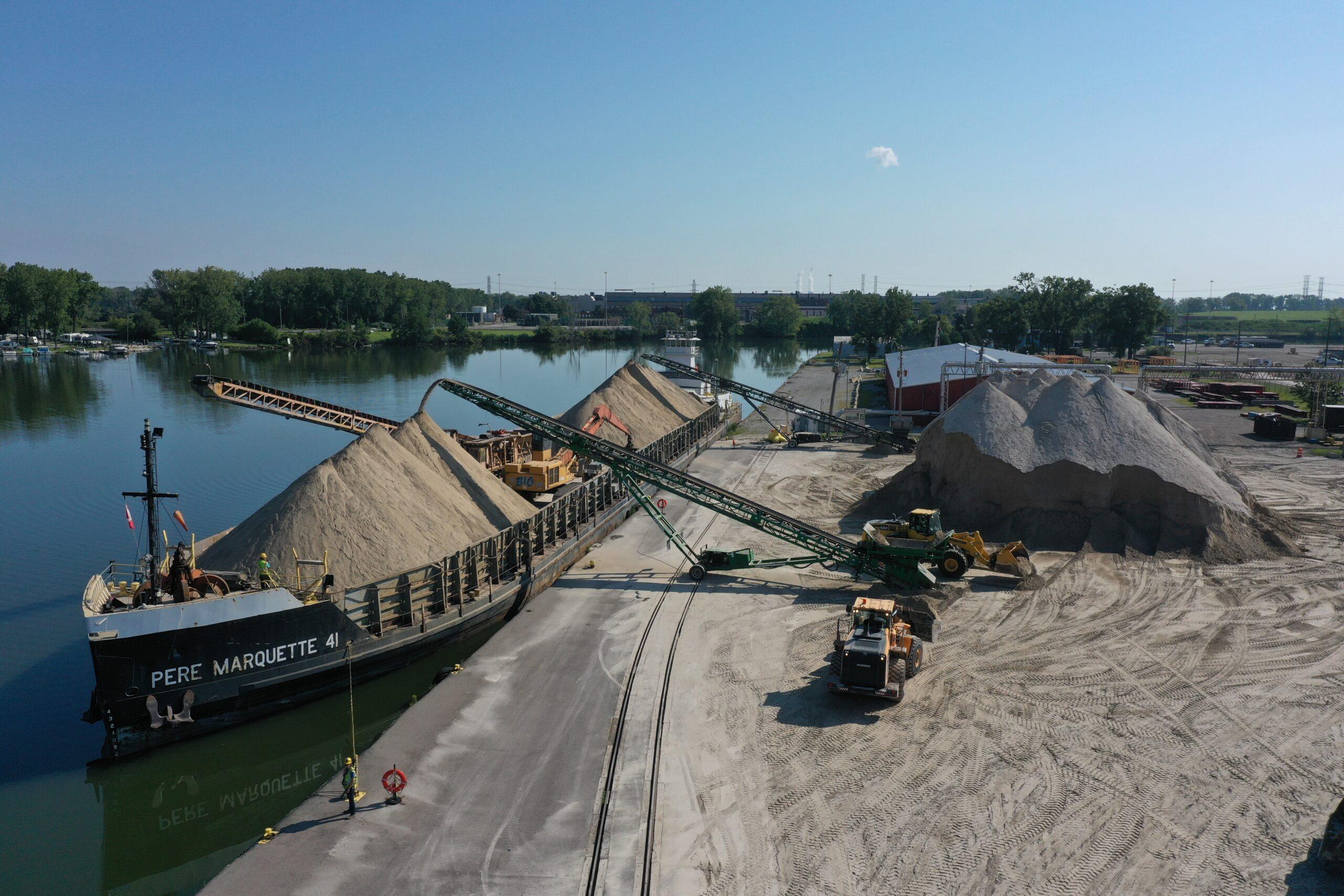

Tug Undaunted with barge Pere Marquette 41 loaded with gypsum for Port Colborne, Ontario. Photo Credit: Samuel Hankinson
August 18, 2021– U.S. Great Lakes ports and the St. Lawrence Seaway handled a deluge of cement, iron ore, petcoke and steel in July supporting the continuing resurgence of manufacturing both in North America and globally.
According to the latest figures, St. Lawrence Seaway cargo volumes from March 22 to July 31 totaled 16.7 million metric tons, up 5% over the same time period a year ago. With total grain shipments from Canada and U.S. down (-12%) from 2020, the overall totals reflect the diversity of the Great Lakes – Seaway system and the breadth of commodity segments and markets that are served.
Within the dry bulk cargo category, pet coke shipments are up 93%. “Pet coke is being exported from the Port of Duluth-Superior and the Port of Toledo to the Netherlands, the United Kingdom and other countries for both steel and cement production,” said Bruce Burrows, president and CEO of the Chamber of Marine Commerce.
Meanwhile, year-to-date iron ore shipments through the Seaway hit 3.5 million metric tons through July, an increase of 23% from a year ago. And cement shipments have topped 1 million tons, up 25% from 2020. “Cement is being transported from manufacturing plants in Ontario and Quebec to ports across those provinces, as well as across the border to Cleveland, Buffalo and Toledo. We are even seeing cement imported from overseas to Duluth-Superior,” Burrows added.
At the Port of Duluth-Superior, 4.2 million tons of cargo was transported in July, the largest July tonnage total since 2015. For 2021, cargo shipments have topped 15.2 million tons. That represents a 40% increase over last year’s pace and is 6% above the five-season average.
“It’s been a good first half of the shipping season and a vigorous rebound from the COVID challenges of 2020,” said Deb DeLuca, executive director of the Duluth Seaway Port Authority. “It’s been especially good to see iron ore tonnage jumping back above the five-season average, because it’s a bellwether of positivity for our port and our region as a whole. Each ore ship carries between $7 million and $8 million in ore value, so while they’re moving a key raw material of everyday life, they’re also moving a sizable amount of commerce for our communities and the North American economy.”
For the season, iron ore shipments have topped 9.5 million tons to finish July 12.6% above the five-season average and 31% above the same time period a year ago.
The Port of Toledo continued to roll through the month of July with tonnage surpassing 2020 totals by more than 30%. Iron ore tonnage increased by 57% to more than 2.4 million tons primarily feeding the Cleveland Cliffs mill in Middletown, Ohio and the new hot briquetted iron facility at the Ironville marine terminal in Toledo. Coal and dry bulk were also up approximately 30% over the 2020 totals with total cargo shipments for all commodities approaching 5 million tons for the season.
“We are certainly in a better place than we were last July when many of our region’s industries were in limbo due to the COVID-19 pandemic,” said Joseph Cappel, vice president of business development for the Toledo-Lucas County Port Authority. “I believe we will continue to see strong demand for raw materials throughout 2021 and, if we can couple that with a good fall grain harvest, our tonnage numbers will reflect a productive year for our terminal operators and the shippers and industries they serve.”
July was a busy month for the Port of Monroe. Among the ship traffic into the Port was the tug New York with barge Double Skin 509A also delivered a cargo of liquid asphalt, while the tug Undaunted with barge Pere Marquette 41 received a load of gypsum for transport to Port Colborne, Ontario.
“We also continue to see vessels call on the DTE Monroe Power plant with coal and scrubber stone shipments,” said Samuel Hankinson, port development coordinator for the Port of Monroe. “We typically see the Paul R. Tregurtha at the power plant, but recently welcomed its fleetmate, the James R. Barker.”
###
Photos can be downloaded at: https://www.flickr.com/photos/marinecommerce/albums/72157657049769546
About the Chamber of Marine Commerce
The Chamber of Marine Commerce is a bi-national association that represents more than 100 marine industry stakeholdersincluding major Canadian and American shippers, ports, terminals and marine service providers, as well as Canadian domestic and international ship owners. The Chamber advocates for safe, sustainable, harmonized and competitive policy and regulation that recognizes the marine transportation system’s significant advantages in the Great Lakes, St. Lawrence, Coastal and Arctic regions.
Media Contact:
Julia Fields
Chamber of Marine Commerce
jfields@cmc-ccm.com
(613) 294-8515
The Chamber of Marine Commerce (CMC) is a bi-national association that represents diverse marine industry stakeholders including major Canadian and American shippers, ports, terminals and marine service providers, as well as Canadian domestic and international ship owners. The Chamber advocates for safe, sustainable, harmonized and competitive policy and regulation that recognizes the marine transportation system's significant advantages in the Great Lakes, St. Lawrence, Coastal and Arctic regions.
Media Contact:
Jason Card
Chamber of Marine Commerce
jcard@cmc-ccm.com
(613) 447 5401